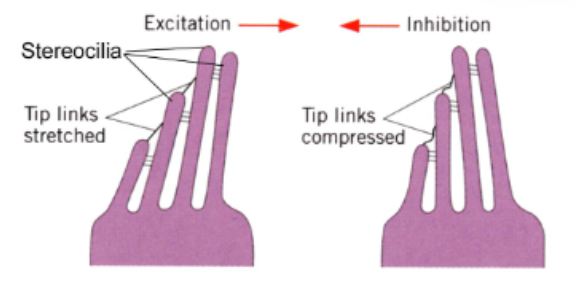Mechanoreception
1/17
Earn XP
Description and Tags
Föreläsning 13/11/2023
Name | Mastery | Learn | Test | Matching | Spaced |
|---|
No study sessions yet.
18 Terms
Latency
Time between the onset of a stimulus and the opening of the first ion channels
How are mechanical forces transmitted?
Transmitted to ion channels directly, without intervening second messangers
The transduction channel detects the deflection of an external structure relative to an internal (eg cytoskeleton). This deflection changes the tension in the system, changing the likelihood of the transduction channel being open, thus altering the flow of ions into/out of the cell, which changes the receptor potential.
Types of mechanoreceptor cells
Receptor cells with cilia
Epithelial cells, found in nematocytes, human inner ears, lateral line organ in fishes/amphibians, and wings/joints/antannae of arthropods/spiders.
Used for detecting touch, pressure, sounds, balance, vibrations, water flow/waves.
Receptor cells without cilia
Nerve cells with cell body in one of the body’s ganglia. May be free nerve endings or Pacinian corpuscles (both in human skin).
Ganglion cells include crustacean stretch receptors, annelid and mollusc touch receptors, human skin/tendons mechanoreceptors, and spindle organs in human muscle.
Somatosensory system
Känsel, ex beröring, tryck, temperatur, smärta, rumsuppfattning…
Ett av de fem klassiska sinnena
Sensory receptors in human skin
Belong to the mechanoreceptors without cilia
Meissner’s corpuscles
Detect pressure and slow vibration
Merkel’s disks
Detect pressure and touch
Pacinian corpuscles
Detect pressure and rapid vibration
Ruffini’s endings
Detect stretch and sustained pressure
Free nerve endings
Detect pain, warmth/cold, and tickle
Hair follicle receptors
Detect tickle and light touch. Only found in hairy skin
Somatosensory cortex
Part of the brain dedicated to deal with impressions on our body surface.
Body parts are respresented in somatotopic order, meaning neighboring locations on the body are repersented by neighboring locations in the brain.

Mechanoreceptors in invertebrates
Long thin hairs
Common receptor in arthropods
Neuromasts
In fish (lateral line organ), usually located in canals under the body service, through which water can pass when currents flow around the body.
Each neuromast is a collection of hair cells, with sensory hairs embedded in a jelly-like substance (cupula), which gets deformed when water flows through the canal. This deformation causes the hairs to bend, causing an action potential.
Proprioception
Monitor blood pressure, joint position, length/tension of muscles, tendons, and guts.
Vertebrate muscle spindle organs
Free nerve endings wrapped around specialised thin musclel fibrers within a muscle.
Measure muscle length
Golgi tendon organs
Sensory receptors in tendons (attach muscles to bones).
Supply CNS with information about the forces generated by muscles
The abdomen stretch receptor in crayfish
Each consists of 2+receptor strands (fine strands of muscle).
Balance
Usually sensed by statolith organs
Sense angle of body relative to gravity and angular acceleration
Statocyst organs
Hold statoliths: small stonelike concretions in a fluid-filled chamber covered by ciliary mechanoreceptors
When tilting the animal, the statoliths move inside the chamber, causing physical deformation of the mechanoreceptive hair cells below the statoliths, triggering action potentials in the neurons.
The statoliths can either move freely in the liquid-filled chamber (mollusc etc), or be connected to the mechanoreceptor hairs (hydrozoans, cephalopods, vertebrates)
In vertebrates, the statoliths are called otoliths, with the otolith organ consisting of the utricle and saccule
Gravity organs in insects
Flying insects use the weight of body parts instead of statoliths
Water-living insects often have air bubbles attached to the mechanoreceptors to sense gravity
Otolith organ
Part of the vestibular system (balansorganet) in the inner ear, along with the semicircular channels (respond to angular acceleration).
The utricule and saccule are both hollow structures filled with endolymph, and a hollow region with hair cells, connected to the macula (gelatinous mass), where the otoliths are embedded.
In mammals, the utricular macula is oriented horizontally (measures direction of gravity), while the saccular macula is vertical (measures linear accelaration).
The hair cells are connected to each other at the tips via tip-links, where the bending of the hair bundle in one direction causes opening of the ion channels (depolarisation of cell= excitation), while bending in other direction, against the shortest hair cell, causes closing of the ion channels and thus hyperpolarisation (inhibition).

Perception of angular acceleration in humans
Three semicircular canals filled with endolymph, each with the ampulla, containing a field of hair cells that project their cilia into a cupula.
When the channel rotates, inertia keeps the endolymph stationary, causing the cupula and the cilia to deform, indicating head rotation.
Note that this is a phasic response, action potentials are only produced at the start of the turn as the head accelerates
Pitch
Frequency of sound = number of times the object vibrates per second. Measured in Hertz. Frequencies below 16 Hz are infrasounds, while sounds above 20 000 Hz are ultrasounds
Sound intensity
The energy the sound contains. Depends on the vibration’s amplitude. Measured in decibel
Invertebrate ears
Cockroaches have mechanoreceptors on the cerci to detect air-flow caused by predators
Mosquitoes have mechanoreceptors in the Johnston’s organ in the second antennal segment.
Crickets have ears in the forelegs, while grasshoppers and cicadas have them in their abdomen.
Moths have ears in the abdomen, used to avoid bats
Human ears
The pinna collects auditory stimuli and funnels them into the auditory canal toward the eardrum.
The middle ear works as an amplifier, as the sound causes the eardrum to vibrate, and the movement is transferred via the three bones (ossicles) (hammaren, städet, stigbygeln) to the oval window of the fluid-filled cochlea. The amplification is needed to overcome the barrier from air to water.
Movement of the oval window causes movement of the fluid in the cochlea, and thus stimulates the hair cells.
Vertebrate ears
Birds, reptiles, and amphibians lack pinna, and the eardrum is exposed. Birds and reptiles only have 1-2 middle ear bones (columella), while amphibians also have a third bone (operculum).